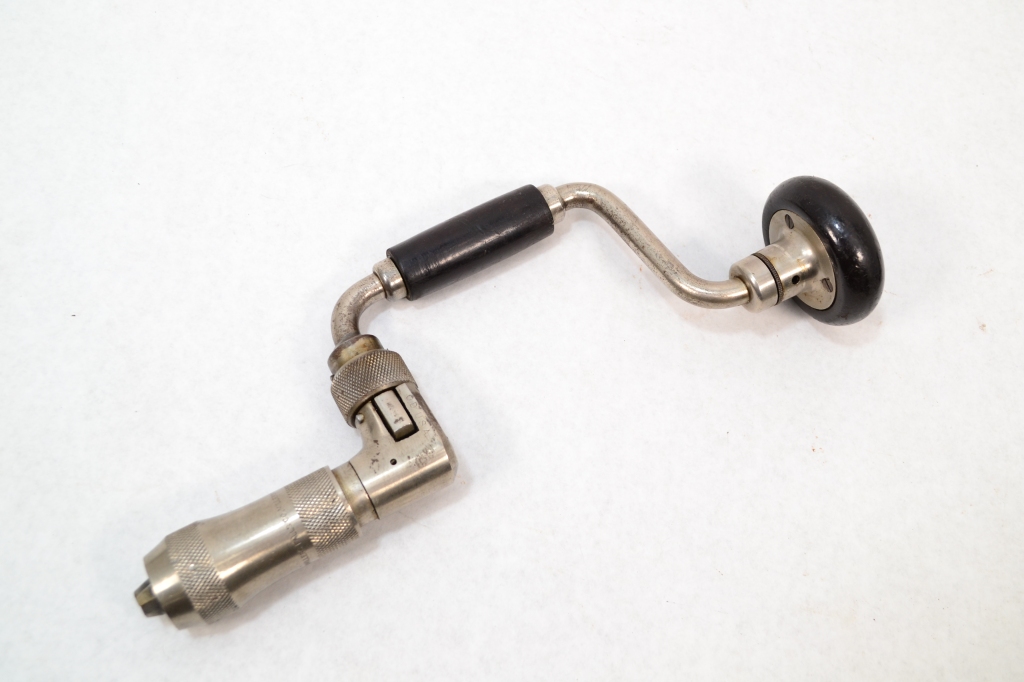
From left to right PS&W 59 1/2, MIllers Falls, Stanley/Fray X3, Stanley/Fray no. 8
For some reason I can’t explain, I have always been interested in small bit braces. I have found an interesting sub type of six inch bit braces that are not only short sweep, but are also more compact in design, barely 12in long overall. Almost all of these braces I’ve come across were marked for the U.S. Ordnance Department. At first I assumed that these were somehow used on bombs, fuses, shells, or other ordnance. It turns out the O.D. had a larger mission during the WWI-WWII era these braces belong to. The US O.D. not only supplied munitions, but also served in an equipment supply/warehousing/repair/safekeeping role. From the Wikipedia entry on the Ordnace Corps:
At the start of World War I, the Ordnance Department was charged with supplying the Army with arms, equipment, and ammunition establishing and maintaining arsenals and depots for the manufacture, repair, and safe-keeping of ordnance, and provide horse equipment and field outfits for Soldiers, such as canteens, tin cups, knives, forks, and spoons. During World War I, the Ordnance Department mobilized the United States industrial base, jointly developed weapons with European allies, and established overseas supply depots and Ordnance training facilities. In 1919, testing was moved from Sandy Hook Proving Ground to the Aberdeen Proving Ground, Maryland. By 1940 all Ordnance training, officer and enlisted was moved from Raritan Arsenal, New Jersey to the Aberdeen Proving Ground, forming the Ordnance School. World War II expanded the Ordnance Department's responsibilities to include production, acquisition, distribution, and training missions for the Army Ground Forces, the Army Air Force, and, in some categories the Navy. In August 1942, the Ordnance Department assumed responsibility for procurement and maintenance of all wheeled and motored vehicles.https://en.wikipedia.org/wiki/United_States_Army_Ordnance_Corps
I have seen a few O.D. manuals and procedure books from this period. They all deal with establishing safe, secure locations for equipment storage. There isn’t much about actual munitions, other than storage procedures. The equipment lists for the O.D. specify a ratchet bit brace, auger bits, twist bits, screwdriver bits, and countersinks. I have found several types of braces marked for the O.D., some of which are shown below. Interestingly, none of these models were shown in any of the catalogs published by these manufacturers at the time they were produced.



The most common example I’ve come across is the Stanley/Fray X3, a compact 6in brace. Almost all examples of this model I have seen were marked for the O.D. These are standard Stanley braces along the lines of a no. 923 brace but more compact and featuring hardwood handles instead of cocobolo.


I have come across several O.D. braces made by John Fray in Bridgeport, CT and later by Stanley after they acquired Fray in 1920. Shown above is a Stanley/Fray no. 8 all iron bit brace with a Spofford chuck. The chuck screw is marked for the U.S. O.D.



Millers Falls made an unnumbered brace for the U.S. O.D. that closely resembles the no. 34 but with hardwood handles. It is similar in style to the Stanley X3 in terms of size and design.



Finally, Peck, Stow, and Wilcox, of Southington, CT produced a compact 6in bit brace model no. 59 1/2.
These interesting compact braces continue to interest me. If you come across any examples that are not shown above please let me know.

Josh – An interesting post Thanks.
I have an OD stamped Stanley X3 and use it quite a bit for boring holes bigger than what an eggbeater can reasonably handle i. e. 1/4” and up. Because of its ‘smallness’ compared to other braces, it doesn’t feel like it devours centre bits. Good too if you’re chucking up a dowel rounder or countersink bit.
My first tour in the Army was at a depot location in Germany in 1981. Being around a large number of Ordnance Corps officers I learned a lot about their branch. (I was Signal Corps) Basically they have – or had then – 2 communities they could work in. ‘Bullets’ – the storage, maintenance and management of all the Army’s destructive stuff and ‘Wrenches’ which was their sort of all other category of maintenance responsibilities. One could bounce back and forth between these two seemingly disparate communities in their assignments if they made the Army a career. So my experience with the Ordnance Corps – what the OD was later rebranded as – matches what you’ve described above. In both types of jobs they needed, then as today, quality hand tools for the real work. One ought not to pass up a chance to pick up an OD stamped tool.
(That said, the standard general service operator level tool kits – the TK 50 and TK 100 – contained a lot of avoidable crap. So quality hand tools were not always procured by the Army. As always caveat emptor.)
Cheers
LikeLike
Rick- thanks for taking the time to write and for your insights into the O.D. I appreciate it!
LikeLike